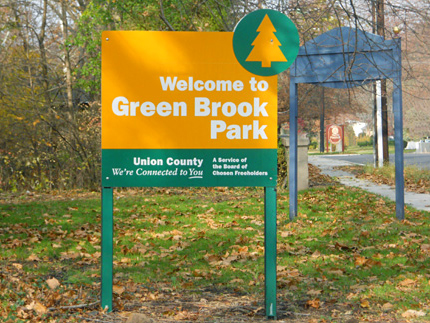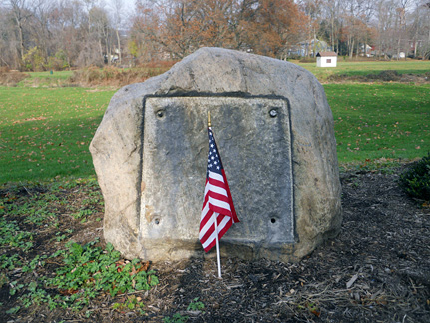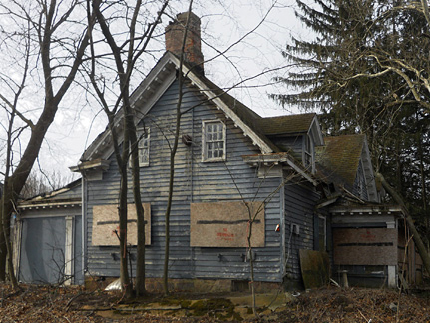





Drake House Museum
602 West Front St.
Map / Directions to the Drake House Museum
Map / Directions to all Plainfield Revolutionary War Sites
For current hours and admission information, see the
Drake House Website
This house was built by Isaac Drake in 1746 for his son, Nathaniel. Nathaniel and his family were supporters of the patriot cause. His sons Abraham, Cornelius and Isaac served in the Somerset County and Essex County militias. [1] The Drake family's freed slave Caesar served as a wagoner for the Continental Army. Nathaniel and Caesar are buried at the Scotch Plains Baptist Church Cemetery, three miles away in neighboring Scotch Plains. [2]
General George Washington was at the Drake House prior to the Battle of the Short Hills in June 1777. [3] Washington and his officers were entertained at the Drake House at other times as well.
The Drake House looks somewhat different today than it did during the 1700's. At that time, it was a four-room, one-and-a-half-story farmhouse. The house was purchased in 1864 by John S. Harberger, who was then president of the Manhattan Banking Company, which is now known as Chase Manhattan Bank. He made architectural changes and additions to the house.
The house is now a museum run by the Historical Society of Plainfield. Its collections and exhibits contain Revolutionary War items. See the museum website for more information.



Site of the Blue Hills Fort and Camp
Green Brook Park
Park Dr.
Map / Directions to the Blue Hills Fort and Camp site
Map / Directions to all Plainfield Revolutionary War Sites
This boulder monument in Green Brook Park marks the site of the Blue Hills Fort and Camp, which was here from December 1776 - June 1777. Unfortunately, at this time the plaque on the boulder is missing and has yet to be replaced. The plaque read in part, "This marker is erected in memory of the brave Revolutionary soldiers from this vicinity who garrisoned this fort harassing and repulsing the invading enemy for seven months during the darkest period of the war." [4]


Jesse Dolbeer House
850 Terrill Rd.
Map / Directions to the Jesse Dolbeer House
Map / Directions to all Plainfield Revolutionary War Sites
Note: this house was demolished June 14, 2016.
The oldest portions of this house dated to before the Revolutionary War,and so it was here as wartime events went on around it. This included the June 26, 1777, Battle of the Short Hills, when retreating Americans and pursuing British would have gone within a half mile of here, and possibly closer. Certainly the sounds of the battle could be heard from the house during the Battle of the Short Hills.
The owner of the house was a wheelwright and carpenter named Jesse Dolbeer, who served in the militia during the Revolutionary War. His wife Esther remained in the house while Jesse was away with the militia.
Jesse's Revolutionary War story is an interesting one. He served in the militia, which meant that he was called into service at different times, rather than continual service as it was for members of the Continental Army. But in that sporadic service, Jesse managed to be involved in a number of important Revolutionary War events in New Jersey.
Jesse Dolbeer
The circumstances of Jesse's birth are not certain, but he was most likely born circa 1747 in Rye, NH. Several years later, his family lived for a time in New Haven, CT, and then moved to Woodbridge, NJ, when Jesse was about 14 years old. He married Esther circa 1775.
When the war began, Jesse and Esther were still living in Woodbridge, and he therefore served in the Middlesex County militia. In June 1776, the Royal governor of New Jersey, William Franklin (son of Benjamin Franklin), was arrested at Perth Amboy by Nathaniel Heard. Jesse Dolbeer was one of a group of men who escorted Franklin after his arrest to Burlington.
Half a year later, Jesse went to Hackensack as part of his militia service, where he took part in another important Revolutionary War event. In November 1776, the Continental Army were at Fort Lee, with General Washington at a headquarters in nearby Hackensack. The Continental Army had just suffered a string of defeats which had led to the loss of New York City to the British. On November 20, British forces crossed the Hudson River from New York City to invade New Jersey, landing several miles from the American troops at Fort Lee and Hackensack. This caused General Washington and the Continental Army to retreat south across New Jersey. Jesse likely made part of this retreat with them, until they reached Woodbridge, where he returned to his home.
Jesse and Esther moved to this house on January 12, 1777, where each of them would live for the rest of their lives. At the time, this location was considered to be part of Westfield, and belonging to Essex County. Union County would not be created until 1857. Jesse continued to be called into sporadic militia service, but now it was as part of the Essex County militia.
On June 26, 1777, less than half a year after moving here, Jesse fought in the Battle of the Short Hills, which took place in the surrounding countryside. At the end of the battle, fighting took place very near this house, as American forces retreated through Scotch Plains, pursued by the British.
In June 1780, Jesse fought in two important Battles about ten miles northeast of here, the Battle of Connecticut Farms and the Battle of Springfield. These battles were the last major Revolutionary War battles fought in the North. Afterwards, the emphasis of the fighting shifted to the southern states, culminating in the decisive Battle of Yorktown sixteen months later on October 19, 1781.
Jesse's wife Esther, whom he had been married throughout his Revolutionary War experiences, died Feb 2, 1783. On July 3 of that same year, Jesse married his second wife, Mary Valentine. Two months later, the Treaty of Paris was signed, which officially ended the Revolutionary War.
Jesse lived for almost five decades after the end of the war. He died Christmas Day 1832, still living at this house at the time of his death. News of his death was carried in the New Jersey Eagle (published in Newark) in its January 18, 1833, edition: "At Westfield, Mr. Jesse Dolbiere [sic], a firm patriot and soldier of the revolution, aged about 90 years."
The location of Jesse's grave is unknown, but it is likely that he is buried in the Scotch Plains Baptist Church cemetery and that his gravestone no longer exists. Gravestones for his first wife Esther, and their son, also named Jesse, who sadly died in 1781 when he was only 10 weeks old, are still located in that cemetery.
Jesse owned another property which is located a half mile down the road at 1230 Terrill Rd in Scotch Plains. That property was lived in by Jesse's son John. Following John's death, another of Jesse's sons, Samuel, moved into that house.

1. ^ Information in this entry about the Drake family and the Drake House was drawn from the Drake House Museum website.
2. ^ Gravestones and boulder marker at the Scotch Plains Baptist Church Cemetery.
• For more information and accompanying source notes about Caesar, see the Scotch Plains Baptist Church Cemetery entry on the Scotch Plains page.
3. ^ Washington's papers from June 24-25, 1777 are marked Quibbletown, which was the name used for the area comprising part of what are now Plainfield, North Plainfield, and Piscataway.
“General Orders, 24 June 1777,” Founders Online, National Archives (http://founders.archives.gov/documents/Washington/03-10-02-0119 [last update: 2015-09-29]). Source: The Papers of George Washington, Revolutionary War Series, vol. 10, 11 June 1777 – 18 August 1777, ed. Frank E. Grizzard, Jr. Charlottesville: University Press of Virginia, 2000, p. 118.
“General Orders, 25 June 1777,” Founders Online, National Archives (http://founders.archives.gov/documents/Washington/03-10-02-0122 [last update: 2015-09-29]). Source: The Papers of George Washington, Revolutionary War Series, vol. 10, 11 June 1777 – 18 August 1777, ed. Frank E. Grizzard, Jr. Charlottesville: University Press of Virginia, 2000, pp. 120–123.
“From George Washington to Colonel Arendt, 25 June 1777,” Founders Online, National Archives (http://founders.archives.gov/documents/Washington/03-10-02-0123 [last update: 2015-09-29]). Source: The Papers of George Washington, Revolutionary War Series, vol. 10, 11 June 1777 – 18 August 1777, ed. Frank E. Grizzard, Jr. Charlottesville: University Press of Virginia, 2000, p. 123.
“From George Washington to John Hancock, 25 June 1777,” Founders Online, National Archives (http://founders.archives.gov/documents/Washington/03-10-02-0124 [last update: 2015-09-29]). Source: The Papers of George Washington, Revolutionary War Series, vol. 10, 11 June 1777 – 18 August 1777, ed. Frank E. Grizzard, Jr. Charlottesville: University Press of Virginia, 2000, pp. 123–125.
“From George Washington to Major General Israel Putnam, 25 June 1777,” Founders Online, National Archives (http://founders.archives.gov/documents/Washington/03-10-02-0125 [last update: 2015-09-29]). Source: The Papers of George Washington, Revolutionary War Series, vol. 10, 11 June 1777 – 18 August 1777, ed. Frank E. Grizzard, Jr. Charlottesville: University Press of Virginia, 2000, pp. 125–127.
4. ^ Plaque erected by Continental Chapter, Daughters of the American Revolution in 1924
• For further reading about the Blue Hills Camp:
• "The Revolutionary Camp Ground At Plainfield, New Jersey" An address delivered before Continental Chapter, Daughters of the American Revolution, January 9th, 1923, by Cornelius C. Vermeule
Available to be read at the Green Brook Historical Society website here• "Some Interesting Facts About the Quibbletown Encampment," Proceedings of the New Jersey Historical Society, Volume VII, No. 3, July, 1922
Available to be read at Google Books here5. ^ Information about Jesse Dolbeer was drawn from a number of sources, including such original documents as Jesse's will, soldier pension application, deeds, and family records. Copies of these documents were provided by Joan Barrett and Sean Lanigan who have done extensive research on Jesse and the house. Joan is Jesse Dolbeer's great-great-great-great-great-granddaughter. Sean is Jesse Dolbeer's great-great-great-great-great-great-grandson.
I would like to thank Joan and Sean for providing me with copies of these documents, and for taking the time to speak and correspond with me.
Notes about particular aspects of Jesse Dolbeer's story appear below:
• Regarding the place and date of Jesse's birth:
~ Langdon Brown Parsons, History of the Town of Rye, New Hampshire: From its Discovery and Settlement to December 31, 1903 (Concord, N.H.: Rumford Printing Company, 1905) Pages 333-334
Available to be read at the Internet Archive here
▸ Baptismal records published in this book state that Jesse was baptized in Rye, NH, on October 11, 1748. The family name is spelled "Dolbee" in this book.
▸ ▸ Other family records support Jesse's having been born in Rye, NH and then moving with his family first to New Haven, CT, and then to Woodbridge, NJ
~ In 1832, Jesse Dolbier made an application for a pension for his military service during the Revolutionary War. The application states that he declared that he was born in Woodbridge, NJ, on August 28, 1748.
▸ It is unknown as to why Jesse would have given this information if it was incorrect.
The possibility exists that it was an error on the part of the scribe who took down Jesse's testimony.
▸ ▸ Whatever the reason may have been for the statement in the pension application, the rest of the documentary evidence leans towards his being born in Rye, NH.
• Regarding the spelling of Jesse's name:
When Jesse applied for his Revolutionary War pension and wrote his will, he spelled his surname "Dolbeer," just as had his father, John Dolbeer. The tombstones of Jesse's first wife Esther, his son Jesse, and his daughter Hannah in the Scotch Plains Baptist Church cemetery also spell the name "Dolbeer."
Joan Barrett states, "Because his sons and their descendants preferred to use Dolbier, Jesse is often referred to as Jesse Dolbier in the many deeds which resulted from his leaving houses and parcels of land to his children. Thanks to the whim of various scribes throughout the years, variations of the name have appeared including Dolbeers, Dollbier, Dolbier, and Dolbeir. Despite all of that confusion, I have only found his first name spelled Jesse in the historic documents."
• Regarding Jesse's profession:
~ Jesse is described as a wheelwright in one legal document (Indenture between John Meeker & Jesse Dolbier - 1791) and as a carpenter in another (Indenture - Jonathan Coles & Jesse Dolbeer - May 1st. 1795).
~ Marion Nicholl Rawson, Under the Blue Hills, Scotch Plains, New Jersey (Plainfield: Interstate Printing Company; Published for The Historical Society of Scotch Plains and Fanwood in cooperation with the Scotch Plains American Revolution Bicentennial Committee, 1974) page 108-109
▸ The author states that in "old deeds and papers" Jesse is described as a wheelwright, carpenter, and carter. However, she does not specify what these deeds were.~ The historic sign in front of the Dolbeer property at 1230 Terrill Road in Scotch Plains describes him as a "wheelwright and blacksmith of the Revolution."
▸ However, none of the known documents identify Jesse as having worked as a blacksmith.
Also, there is no record of his having performed work as a wheelwright as part of his militia service in the Revolutionary War.
• Regarding the date when Jesse and Esther moved into this house:
~ Jesse's pension application states that after living in Woodbridge, he then moved "to the said County of Essex in said State of New Jersey on the Twelfth of January 1777."
While it is likely that he moved into this house at that time, there is a small possibility that he moved to this area on January 12, 1777, but then first lived in another house before moving into this house. Jesse was known to own several other properties in this area at various times, including the house at 1230 Terrill Rd. in Scotch Plains, where his sons John and Samuel lived at different times.
The oldest known deed placing Jesse in this house is from 1791. This means that while it is likely that Jesse lived in this house beginning on January 12, 1777, the documentary evidence does not prove that he lived here prior to 1791. The documentary evidence does prove that Jesse continued to live in this house until his death in 1832.
• Regarding Jesse's Revolutionary War record:
~ Details of Jesse's Revolutionary War experience was drawn mainly from his Pension application. Some interpretation and extrapolation was made on my part to interpret his recollections with known events, as his remembrances were made more than five decades after the Revolutionary War ended.
~ For more information and accompanying source notes about the specific Revolutionary War events and battles mentioned in the entry, see the individual town pages linked from within the text.
If anyone would like to correspond with Joan Barrett regarding Jesse Dolbeer or this house,
she can be reached at joan_e_barrett@yahoo.com